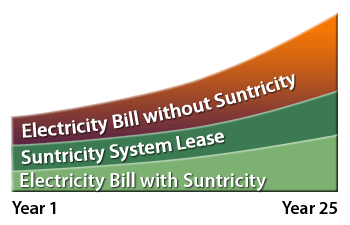
Call: 1 (310) 459-7062





|
|
Suntricity Residential Systems
Solar Systems Make $ense for Your HomeThere's never been a smarter time to invest in a solar system for your home and save money on your electric bill. With available federal, state and local rebate programs and today's low interest rates, solar power is affordable for everyone. The federal tax credit covers 30% of the system cost, and with additional state and utility rebates of up to 50% available, you can cut the net cost of a solar system by more than 50%.
With a Suntricity solar system, you and your family can feel good about doing your part to clean up the environment and reducing our nation's dependence on foreign oil. Financing Your Suntricity Solar SystemA solar system from Suntricity will save you money, lock in low electricity costs, and protect you from rising utility bills. With available rebates and low-interest financing, there's never been a better time to invest in a solar system. The federal tax credit covers 30% of the system cost, and additional state and utility rebates can cut the net cost of a solar system by well over 45%. And, available financing for qualified buyers can enable you to finance the balance of your system's cost. You can purchase you system with no money down and still save money on your monthly utility bill. If you elected to pay off the balance in cash, the system would pay for itself in less than five years. Rebate Programs Dealing with government programs can be challenging. Suntricity identifies all of the qualifying programs for your system and files the paperwork for you. To determine saving available to you through solar incentive programs, call us to set up a free consultation.
Additional Information on Solar Incentive Programs
Solar Panel Basics for Your HomeSolar panels consist of photovoltaic (PV) cells that convert sunlight into direct current (DC) power. These panels, usually installed on rooftops, have no moving parts and last at least 25 years. The DC power generated by the solar panels travels to an inverter, which converts it into alternating current (AC) power, the standard electrical current used in homes and commercial buildings. From the inverter, AC power moves to the electrical panel, or breaker box, where it is now ready to use in your home or commercial building. Even with a solar system, your property must remain connected to the utility grid to provide electricity at night and during other periods when more power is needed than the solar system can produce. The amount of electricity consumed is measured by a utility meter. Because we have what is called "Net Metering" in California, if a solar system produces more power than needed, the meter actually spins backwards, accumulating credits with the utility company that will offset your next bill. |
Residential | Commercial | Free Consultation | Solar Calculator | Financing
About Suntricity | Contact Us | Copyright 2024 Suntricity. All rights reserved.
 A Suntricity solar system can instantly shrink your electric bill by an average of 65%. What's more, your savings will go up as utility rates rise. Electricity rates in California have risen an average of 5% annually for the past three decades and are anticipated to increase by 8% in the next 2 years. A solar system locks in low electricity costs and protects you from rising utility bills.
A Suntricity solar system can instantly shrink your electric bill by an average of 65%. What's more, your savings will go up as utility rates rise. Electricity rates in California have risen an average of 5% annually for the past three decades and are anticipated to increase by 8% in the next 2 years. A solar system locks in low electricity costs and protects you from rising utility bills.